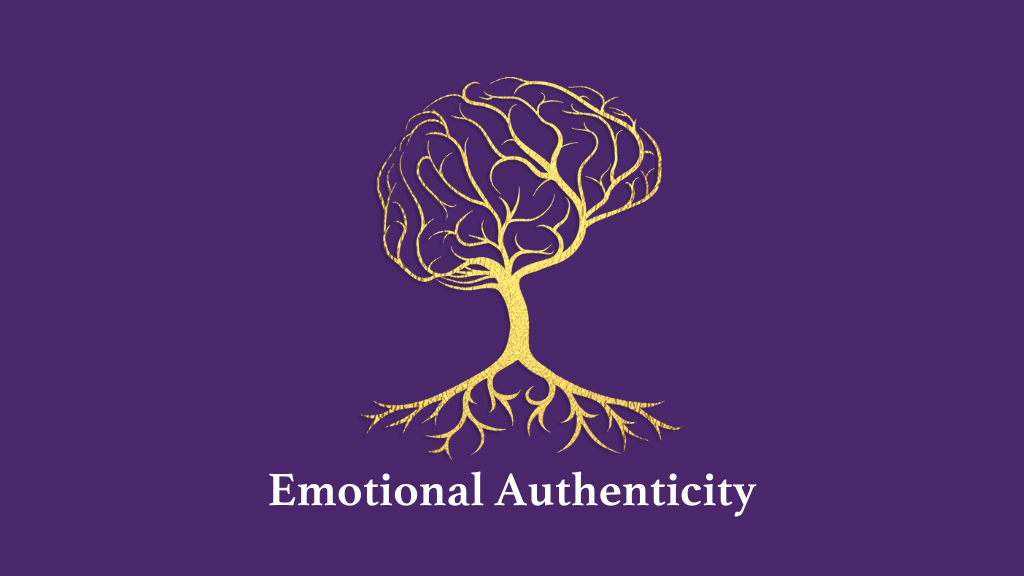Emotional Authenticity

Where Emotional Intelligence (EQ) and Cognitive Behavioral Therapy (CBT) scratch the surface of emotional awareness, My Complete Emotional Authenticity Method provides several advanced solutions that profoundly elevate your internal emotional landscape to a depth and understanding that CBT and EQ do not offer you. Emotional Authenticity dissolves the mysteries and complexities of discovering who you really are by providing a trailblazing process that uncovers what keeps you from living in your authenticity and truth, thus paving the way to manifesting your destiny.
Rooted in the latest neuroscience and psychology and my own journey in overcoming my detachment from myself, my cutting-edge Emotional Authenticity approach to identifying and living in your authentic self provides you with the tools and strategies necessary for healing and self-discovery.
Let me show you how:
With CBT, you are encouraged to reevaluate a situation by describing it differently or diverting your attention, thereby suppressing your emotions. While CBT can offer some help, ultimately, it’s limiting. You can’t overcome feelings through intellectualizing or trying to be rational since the state of your body, interoception, and affect are built into every memory, perception, thought, and emotion. Those emotional and feeling networks dominate intellect at every moment of your life. Therefore, the CBT process only strengthens the left-hemisphere dominance, which we now know is the antithesis of your goal.
As helpful as CBT can be with self-healing, it does not cover the depths of work that encompasses the scope of connecting back to your truth and authenticity. Pete Walker reinforces this in his book about the obstacles of trauma, Complex PTSD: From Surviving to Thriving:
“Although CBT is a widely accepted form of therapy and even effective in various personality disorders to an extent, it does have its limitations. Since its approach leans largely on present moment focus, CBT fails to address the emotional root cause and overlooks the left hemisphere traumatic memory recollection that activates the wounded emotional reactions. For more severe pain surfacing from a highly adverse childhood, CBT may only scratch the surface of neutralizing and healing negative emotional patterns.”

How Does Emotional Authenticity Help You More Than CBT
Starting with CBT, let’s look at examples of the differences between approaches. Assume for a moment you are afraid of snakes. The CBT model might have you describe it as:
“Beautiful, safe, and peacefully coiled up before you.”
In other words, ignore the emotional context and try to overcome the negative emotions with a positive, left-side intellectual, emotionally repressive, rational reappraisal. In contrast, Emotional Authenticity will have you create as much specificity, depth, and breadth of your emotions and suggest a possible new concept that can lead to a new definition.
This new approach will have you describe your experience with a snake as follows:
“I feel petrified and feel breathtakingly afraid, and my stomach feels like it’s in knots looking at this slithering, disgusting, slimy, evil, menacing creature, and yet I am open to possibly feeling different about it.”
Studies have shown that becoming as specific as possible with our emotional words to describe an experience causing us distress is the most effective way to reorient the emotion while providing the most long-term beneficial results. This is called Negative Emotional Differentiation, or NED.” Basically, you need to know how you feel to change how you feel.”
How Emotional Authenticity Helps You More Than Emotional Intelligence.
Emotional intelligence (EQ) broke boundaries and was instrumental in our beginning to discuss the importance of emotions. Frankly, I wouldn’t have a career if it weren’t for Emotional Intelligence. It attempts to improve people’s self-awareness, self-management, social awareness, and relationship management skills. While it offers some helpful hints, unfortunately, its process is like trying to tell somebody how a leaf on a tree got there without telling them about the branch, trunk, roots, or seed. If you don’t know that all leaves are constructed from a seed, and the soil determines its development, or that its energy is stored in the trunk and the branches, then you won’t understand what produced the leaf or how to formulate the leaf you desire.
To begin with, EQ is based on the old inaccurate triune brain model, which supposes we have an emotional part of the brain that simply needs taming. This theory of the brain’s design was disproved before the book was written. More profoundly, they don’t drive home the point that the root of all adult emotional reactions comes from your childhood experiences, society messages, and the state of your body. They lightly suggest your current emotional response might originate from a stored memory of a similar experience with someone in your childhood. However, they do not provide an in-depth, accurate process to clarify that you did, in fact, learn your reactions and definitions as a child.
In short, Emotional Intelligence does not tell you that the root, trunk, branch, and leaf of your current-day emotional reactions and definitions all come from childhood, and they need to be healed and reframed to achieve what they propose. Nor do they inform you how the society in which you were raised influences the emotional definitions you establish and will color how you respond emotionally.
Additionally, they don’t provide a process to reconnect to your body, which plays a significant role in all emotional reactions. Finally, since they don’t offer any education on emotional self-deception or codependence and how they influence your relationships, they don’t deliver on their promise to make you more aware of other people’s emotions. By not thoroughly addressing the three emotional creators of childhood, society, and your body, you can achieve nothing more than a shallow level of EQ because it superficially focuses only on the outer edges of the emotional self-awareness, self-management, social awareness, and relationship management puzzle.
On the other hand, Emotional Authenticity provides you with the root, trunk, branch, and leaf of the emotional self-awareness, self-management, social awareness, and relationship management puzzle. For starters, Emotional Authenticity is built on an updated understanding of how the brain generates emotions. We now know that while certain parts may play a heavier role, every section of the brain borrows from and works in concert with all other elements when we express emotion or logic. The conductors of your brain’s emotional symphony include your parents, society, and the state of your body. All three construct the tune of emotional simulations, concepts, and definitions you play in your adult life.
Emotional Authenticity shows how you were taught and are stuck replaying out-of-tune, self-sabotaging childhood emotions. More importantly, Emotional Authenticity gives you the solution you need to get all three back on the same sheet of music by increasing your emotional language and specificity. In addition, Emotional Authenticity succeeds in changing your physical simulations, concepts, and definitions for past and present emotional events by reconnecting to your bodily sensations. These transformative solutions are critical because all adult emotional responses are the brain re-enacting our earliest emotional memory definitions and must be updated. Emotional Authenticity also includes a codependence recovery plan and relationship confrontation model, without which it is impossible to be aware of other’s feelings and emotions. Therefore, only Emotional Authenticity provides a thorough, proven method to understand “where” and “how” you learned your emotional and feeling definitions and a cathartic solution to heal your hurt, pain-filled, self-sabotaging ones. That is not all. By expanding your emotional language, awareness, and connection to yourself, only Emotional Authenticity makes you conscious of and provides a solution to overcome your emotional denial and self-deception by coordinating with the Authentic Self Cycle of truth, responsibility, healing, and forgiveness.
Therefore, you can think of the EQ process as going to grade school and the Emotional Authenticity method as getting your Doctorate in emotional development. Emotional Authenticity and the Authentic Self Cycle synchronize to give you complete emotional self-awareness, self-management, social awareness, and relationship management skills. By conducting the root, trunk, branch, and leaf into a harmonious, symphonic melody, they fill the middle of the puzzle and complete Your Journey To Being Yourself.
The 10 ways Emotional Authenticity helps you more than Emotional Intelligence
- Emotional Authenticity is based on the latest neuroscientific model of the brain and how it processes emotions. EQ is based on a brain model that was disproved before the book was written.
- Emotional Authenticity shows you how all your emotion and feeling definitions are learned in childhood, thus giving you complete emotional self-awareness.
EQ does not. - Emotional Authenticity provides a process to show you how those learned definitions are painfilled, and emotionally sabotaging.
EQ does not. - Emotional Authenticity provides a process to replace your self-sabotaging, pain-filled emotional definitions with new, empowering ones that reattach you to your authentic self.
EQ does not. - Emotional Authenticity provides a process to reconnect you to your body and change your physical feelings which is critical since we feel our emotions physically.
EQ does not. - Emotional Authenticity provides a process to heal the hurt and self-sabotaging emotions from childhood so you can reclaim your authentic self.
EQ does not. - Emotional Authenticity provides a codependence recovery plan and relationship confrontation model which makes it possible to be aware of other’s feelings and emotions.
EQ does not. - Emotional Authenticity provides a process to overcome your emotional denial and self-deception which you must have to connect with others and live in your authentic self.
EQ does not. - Emotional Authenticity provides the processes to achieve complete emotional self-awareness and the solution to living in your authentic self.
EQ does not. - So, while EQ forms the outer edges, only Emotional Authenticitysolves your emotional self-awareness puzzle by filling in the middle, thereby completing your Authentic Self journey.
The process toward Emotional Authenticity involves engaging with your first emotional concepts and definitions and expanding your feeling words to describe them. With this emotional and feeling specificity, you can grieve and let go of the pain from the past. Now that the emotions are no longer suppressed and denied, there is space available to bring in new empowering emotional concepts and definitions. Your brain can now shape itself based on these new positive emotional experiences.
By developing your Emotional Authenticity skills, you can effectively turn a self-sabotaging emotional experience into something that no longer resonates as a negative feeling or emotion. In this new emotional space, you can create safe, healthy, loving relationships.
With Emotional Authenticity, you are now in complete control of your emotional landscape with the ability to reclaim your authentic self.
Contact

